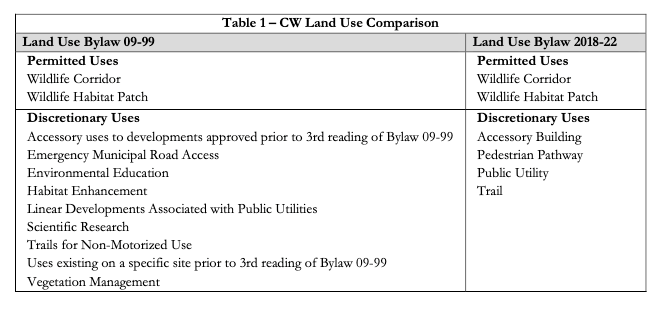CANMORE – Before Canmore's elected officials voted to approve third and final reading of an updated Land Use Bylaw, two discretionary uses were removed from a district that mistakenly could have ended up costing taxpayers millions of dollars.
The two land uses were part of the conservation of wildlands (CW) land use district in the bylaw and recognized existing uses on specific sites that were approved prior to the 1999 Land Use Bylaw (LUB). Specifically, they related to two single family homes located on the outside edge of Canmore's urban growth boundary near Harvie Heights, the east end of the Stewart Creek Golf Course, Thunderstone Quarry and the Banff Gate Mountain Resort near Dead Man's Flats, and Canmore Ranch off Bow Valley Trail.
Development planner Nathan Grivell explained the intention was to reduce redundancy and provide clarity around non-conforming uses, however by removing them council triggered unintended consequences under the Municipal Government Act (MGA).
Grivell said if council does not reinstate the uses in the bylaw, the municipality would be forced into a position to have to purchase these properties.
"The key message here is that failure to reinstate these uses would put the Town in the position to have to acquire the impacted lands," he said. "When these uses were removed, it removed all development potential for these lands and when you do that it can be seen as a de facto taking of land."
The change to the Land Use Bylaw triggered section 644 of the MGA, which requires the municipality to acquire the lands affected within six months of adopting the legislation.
By removing the specific uses related to these sites, Grivell said council has designated the properties for its own purposes and compensation would be required to address that removal of future development potential.
The updated LUB came into effect on April 1, 2020 and there was intent from elected officials and administration for it to provide greater clarity on what uses are permissible within the Town's land use districts.
When a use is removed from a district, any existing uses approved prior to that change are allowed to continue and are then considered legal but non-conforming uses, which is addressed in the bylaw and the MGA. As a result, the use is allowed to continue despite the fact the rules have changed since it was originally approved.
Grivell noted, however, that a legally non-conforming use no longer has the opportunity to develop or expand. He said it is tough to argue that these particular properties would have the opportunity for future development, as the permitted and discretionary uses in the district only allow wildlife corridors, habitat patches, accessory buildings, pathways, public utilities or a trail.
Under section 644 of the MGA, it states that if land is designated or intended for use as a municipal public building, school, park or recreation facility and the municipality does not own the land, it must within six months of the re-designation purchase the land or require it be provided as reserve; commence proceedings to acquire it or amend the bylaw.
As a result of this section of the act, Grivell said council cannot remove development potential from land to the point that it deprives the owner of any use of it. He said by removing discretionary uses that allowed accessory uses to developments and existing developments approved prior to the 1999 LUB being approved – council effectively deprived those landowners of future development potential even though that was not the intent of the change.
"It could be argued that this is a flat-out taking of land by the municipality," Grivell said. "In order to avoid significant capital costs, administration recommends council give Bylaw 2020-17 first reading and schedule a public hearing."
As a result, administration returned to council on Sept. 1 with an amending bylaw to reinstate those discretionary uses in the CW district. Council voted in favour of first reading and scheduled a public hearing for Sept. 22.
Grivell noted that by returning the uses to the district, they remain discretionary and would require an environmental impact statement should future development be proposed. Furthermore, several of the properties are located outside the urban growth boundary, which would also need to be changed under the Municipal Development Plan before an expansion of development is considered.
Mayor John Borrowman said the municipality and council have no intention to purchase any of the lands affected as a result of this mistake.
"If we have made a substantive error in the approval of the Land Use Bylaw, it is appropriate that is addressed given the information we have been provided," Borrowman said.




